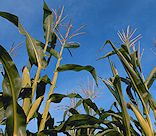
Farmers planted a larger number of acres to corn this spring than expected - easing pressure on food prices and on ethanol producers - but trimming prices and profits for corn growers. USDA's 2009 Planted Acreage Report, released June 30 and based on government surveys, shows farmers nationwide planted 87 million acres of corn, the second-largest amount since 1946, and an increase of 1 million acres from a year ago.
That 1-million acre increase means U.S. corn plantings are up 1% from a year ago while U.S. soybean plantings are up 2%. The U.S. soybean acreage is a record 77.5 million acres in 2009.
Corn futures on the Chicago Board of Trade sent the market down the limit of 30 cents a bushel after the acreage estimate was issued June 30, and analysts say prices could be headed lower if weather this summer is good and yields are favorable. "The price of corn could go down to around $2.90 a bushel in July," said commodity broker Sue Martin, president of Ag & Investment Services at Webster City, Iowa. A year ago corn soared to nearly $8 on fears that Iowa's floods had damaged the crop.
Iowa also planted more corn acres in 2009
Iowa farmers also increased their corn acreage. Iowa farmers planted 13.7 million acres of corn this spring, compared with 13.3 million acres last year.
Of course, it's still a long way until harvest. But this year's increased acreage in the U.S. and Iowa is already hitting corn growers in the wallet as prices look like they are headed lower than previously forecast for the year. However, the crop also could take some of the political heat off of corn growers and ethanol producers, who are struggling to maintain public support for government biofuel incentives. Economists say there should be enough grain supplies to serve all uses, from cattle feedlots to ethanol plants to food manufacturing.
USDA also reported on June 30 that a record 77.5 million acres of soybeans were planted nationwide this spring, up from 75.7 million in 2008. In Iowa, farmers planted 9.8 million acres of soybeans, up slightly from last year's 9.75 million acres.
More corn is good news for livestock, ethanol
Corn for feed is a major production cost for cattle, hogs and poultry, which have been struggling financially in a weak global economy that has reduced the demand for meat. The increase in corn plantings is good news for livestock and poultry producers, says Paul Hill, a turkey grower and corn and soybean farmer from Ellsworth in central Iowa. He points out that the 2009 increased corn acreage provides some short-term relief but doesn't eliminate the livestock and poultry producer's concern about the federal government's mandates for increased ethanol production.
About one-third of this year's corn crop, or 4.1 billion bushels, will be used for ethanol. The 2009 increase in corn acreage helps provide more corn for livestock feed, but the problem is that the ethanol mandate increases every year, too. Profits in the ethanol industry were hit hard this past winter and spring by the drop in crude oil prices and the relatively strong price for corn. So, a decline in corn prices not only helps the ethanol producer's bottom line but makes it easier to defend the mandates and other government biofuel incentives.
"The increase in 2009 corn acreage should give policymakers an indication that the market is working and there will be more than enough grain for food and fuel," says Bruce Rastetter, chief executive of Hawkeye Energy Holdings LLC, which operates four ethanol plants in Iowa. The increase in corn plantings could have another benefit for ethanol by making it easier for the Obama administration to raise the limit on the amount of ethanol that can be added to gasoline. The current limit is 10%. The ethanol industry wants the administration to raise the blend cap to 15% to increase the market for fuel ethanol.
Corn supplies are expected to tighten in 2010
While the price outlook for corn and beans may turn out to be lower than previously expected this year, it doesn't mean there will be a big decline in feed costs.
Bob Wisner, a retired Iowa State University Extension grain market economist who now works for the Ag Marketing Resource Center at ISU, sees corn and soybean meal prices continuing at levels that are much higher than just a few years ago, although well below the highs of 2008 and this spring. For the rest of this year, crop prices will depend heavily on yield prospects, especially in the eastern Corn Belt, where much of the crop was planted very late. For the next couple of years, Wisner's projections show modestly tighter corn supplies unless U.S. yields are well above normal.
Part of the anticipated tightening of supplies is due to an estimated 675-million bushel drop in the spring 2009 South American crop, which should strengthen U.S. export demand. Also, current corn prices are generating improved profits for ethanol, and increased government mandates will encourage substantial expansion in the ethanol industry.
The 87 million acres of corn planted in the U.S. in 2009 is 2 million more corn acres than USDA had projected in its March 2009 Planting Intentions Report, which is a national survey of farmers prior to spring planting season.
"There's plenty of corn to go around this year. For the year ahead, the 2 million extra corn acres USDA found in their June acreage report will delay the prospects for tighter supplies," says Wisner. "But we see a need for another 1.5- to 2-million corn acres in 2010. Some of that is due to expanding ethanol mandates and indications that China may begin to import corn."
About the Author(s)
You May Also Like




